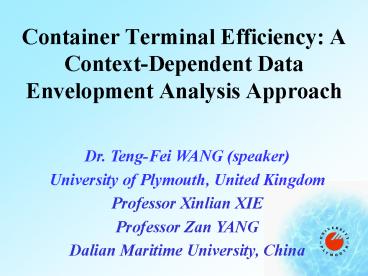Container Terminal Efficiency: A ContextDependent Data Envelopment Analysis Approach - PowerPoint PPT Presentation
1 / 17
Title:
Container Terminal Efficiency: A ContextDependent Data Envelopment Analysis Approach
Description:
Container Terminal Efficiency: A Context-Dependent Data Envelopment ... 2001; Valentine and Gray, 2001; Barros and Athanassiou, 2004; Turner, Windle and ... – PowerPoint PPT presentation
Number of Views:84
Avg rating:3.0/5.0
Title: Container Terminal Efficiency: A ContextDependent Data Envelopment Analysis Approach
1
Container Terminal Efficiency A
Context-Dependent Data Envelopment Analysis
Approach
Dr. Teng-Fei WANG (speaker) University of
Plymouth, United Kingdom Professor Xinlian
XIE Professor Zan YANG Dalian Maritime
University, China
2
Introduction
- Data Envelopment Analysis (DEA) has widely been
applied to the container port/terminal industry - Roll and Hayuth 1993 Martinez-Budria et al,
1999 Tongzon, 2001 Valentine and Gray, 2001
Barros and Athanassiou, 2004 Turner, Windle and
Dresner, 2004 Cullinane, Song and Wang, 2005
Cullinane, Song, Ji and Wang, 2004 Cullinane, Ji
and Wang, 2005 Cullinane, Wang, Song Ji, 2006
3
Some (potential) weaknesses of the existing
research
- Do these most frequently DEA approaches always
make sense in practice? - Can annual data, which have most frequently been
used in the existing literature, be a problem? - Does Chinas container terminal industry deserve
further research given its rapid development?
4
Data Envelopment Analysis in Theory
- To measure the relative efficiency of a
homogeneous set of production units termed
Decision Making Units (DMUs) where the presence
of multiple inputs and outputs makes comparisons
difficult. - DEA utilises the concept of the frontier of the
production possibility set and constructs a
piecewise linear frontier to benchmark each
individual production unit. The efficiency of
each production unit is no more than unity.
5
In practice what is homogeneous? Is each
container terminal unique?
Sample
Too small
6
In practice what is homogeneous? Is every
container terminal unique?
Sample
Too small
Too big
A risk to lose the homogeneity!!
7
Traditional DEA
a
Output 2
k
d
e
c
f
h
Output 1
8
Context-dependent DEA
- Context-dependent DEA refers to a DEA approach
where a set of DMUs are evaluated against a
particular evaluation context. - Each evaluation context represents an efficient
frontier composed by DMUs in a specific
performance level.
9
Can annual data, which have most frequently been
used in the existing literature, be a problem?
10
Top container ports in the world (2005)
11
The locations of the main ports in China
12
Data collection
- There is little that can be measured on a whole
port basis. Most comparable data must concentrate
on a terminal basis (Alderton, 1999). - Two groups of data relating to 32 container
terminals in China are collected for analysis. - The first group of data include the annual
container throughput of these container
terminals. - The second group of data include the maximum
monthly volume of containers handled by different
terminals.
13
Average efficiency of container terminals in
different regions
north
Central
south
14
Data and efficiency
15
A selection of terminals with highest and lowest
efficiency
16
Different layer of frontier identified by
context-dependent DEA approach
17
Concluding remarks
- This paper demonstrates the potential usefulness
of context-dependent DEA approach, further
research should be directed towards the
implementation of this approaches to practice. - During this process, a close communication with
terminal/port practitioners is absolutely
necessary.

